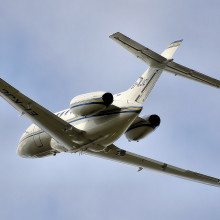This week, we find out if an aeroplane on a treadmill could the plane still take off, and ask how air is made in space, and if electric eels suffer from self-shock syndrome...
In this episode

Treadmill runway?
Tim Sabey, Pilot & Ex-physicist:In order to take off, an aircraft must have sufficient vertical forces to counteract its weight. The major component of this upwards force is lift. Lift is generated by airflow over the wings creating a lower pressure distribution on the upper surface compared with the lower. This has the effect of deflecting air downwards as it passes over the wing. The equal and opposite reaction force of this is upwards and called lift. Lift is dependent on the aircraft speed so the aircraft must be at sufficient speed, typically 130-150kts for a commercial jet to take off. The second upwards force is the vertical component of the engine's thrust as when the aircraft nose is pitched up part of the thrust vector will be vertical. The aircraft will accelerate down the runway by its engines. These accelerate air backwards and again the equal and opposite reaction force on the plane is in the forwards direction, known as thrust. In the situation described there is a conveyor belt which automatically tracks the aircraft ground speed and moves at that speed but in the opposite direction. Since the aircraft is not accelerated by means of contact with the ground (like a car does) the only effect will be that the wheels spin faster so there is more friction. The aircraft will still be able to accelerate to a speed that produces enough lift to take off. This will increase the runway length required but given that is sufficient it will still be able to take off.Diana: If a plane was to reach take-off speed from motorised wheels:Terry Holloway, Marshall Cambridge, Group Support Executive:In this particular instance the assumption is that the aeroplane is sitting on this mobile conveyor belt runway. As the aeroplane gains speed and goes forward so the conveyor goes backwards at an identical speed. Let us say hypothetically that this particular aeroplane that we're talking about would normally take off at 100 miles per hour. When it reaches a forward speed of 100mph, in other words its wheels on the runway, the conveyor is going backwards at 100mph but the aeroplane's speed through the air is zero. There's no air flowing over the aerofoil section of the wing which produces the lift. Therefore the aeroplane won't fly.










Comments
Add a comment